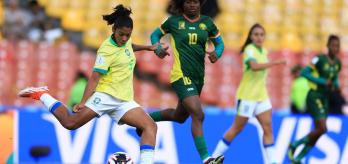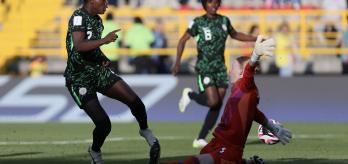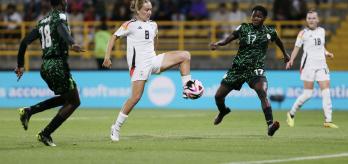With this in mind, the way Brazil have used one of their three centre-backs to create midfield overloads and break lines during the early rounds of FIFA U-20 Women’s World Cup Colombia 2024™ piqued the interest of the team on the ground in Medellín.
As Anna Signeul explains, Brazil’s approach is interesting because it has caused genuine challenges for the teams they have faced.
“In their game against France, Brazil played with a 1-3-4-3 system using their central centre-back, Rebeca (5), as a line-breaking overload player. It’s a very interesting strategy because she does not do it all the time, it depends on the situation, and she chooses the moments. What’s even more interesting is how her team-mates respond when she progresses up the pitch, indicating that this is something they have really trained for, and is not impulsive.”
CREATING OVERLOADS
As can be seen in the graphic below, France operated in 1-4-4-2 formation against Brazil’s 1-3-4-3, with a 4v4 match-up for both teams across the midfield line. Brazil liked to build their play, switching between their three centre-backs before progressing the ball. On certain occasions (with and without the ball), Rebeca advanced into midfield, operating in the space between France’s two centre-forwards and two centre-midfielders, creating a 3v2 overload in the middle of the pitch. Often when this happened, Brazil maintained defensive balance with one or both wing-backs dropping deeper to reduce the threat of the French counter-attack.
As Signeul explains, this midfield overload would sometimes unsettle France’s team structure, causing confusion around who should pick her up defensively.
“France’s out-of-possession structure meant they were operating in quite straight lines so when Rebeca stepped into this space, she was sometimes free to go forward with the ball because the defending midfielders ahead of her were occupied. If a defending player left their allocated player to press her, she was happy to go 1v1 and take them on. There was real intent in what she was doing, and she wanted to progress the ball.”
As can be seen in clip 1 below, at times, Rebeca advanced from the backline to act as a pivot/playmaker for her team. As Brazil’s right and left-sided centre-backs build the play, their central centre-back moves in between the two France forwards. Once Rebeca established her position in the midfield space, their right wing-back, Gi Fernandes (2), drops alongside the two centre-backs, while Brazil’s two centre-midfielders, Vitoria Amaral (10) and Lara (17), keep France’s two midfielders occupied. Once Fernandes receives the ball, centre-forward Vendito (7) drops in creating an offer to receive, while Rebeca advances, making a forward run, becoming an overload player approaching France’s defensive line. Vendito plays a short pass to Rebeca who plays a line-breaking forward pass in behind for right forward Milena (16).
Penetrating midfield runs
A characteristic of Rebeca’s attacking prowess that caught the attention of our TSG was the variety in her play once she had advanced from the centre-back position. Her unorthodox forward movements sometimes happened with the ball, as she demonstrated a willingness and technical ability to drive forward and progress play. Again, this caused problems for defending players who were already occupied as she arrived in parts of the pitch where she was not expected.
As Signeul explains, “In clip 2 below, we see an excellent example of how Rebeca broke lines in areas of the field where centre-backs would not normally be operating. From this throw in, she comes into space unexpectedly and France have not accounted for her in their defensive set-up. She takes her first touch forward and almost immediately breaks France’s midfield line. It is interesting to see how her team-mates stay in their positions and out of her way, giving defenders decisions to make. Should they go to challenge her and leave a player free, or stay with the player they are expected to mark? With no challenge forthcoming, she continues her run and breaks the defensive line before crossing to the backpost, creating a strong goalscoring opportunity for her team.”
MOVEMENT AROUND THE FREE PLAYER
By moving (and sometimes by not moving), Brazil’s players played a key role in the creation of the space that Rebeca penetrated. The timing of the forward runs and positions adapted by the centre-back were carefully considered and not impulsive (she did not do it all the time). When she advanced from her traditional position, it was clear that her team-mates were expecting these movements and knew what to do when it happened.
Sometimes centre-midfielders and forwards pulled wide, dragging opposition defenders with them, and consequentially, opened space for Rebeca to drive through unopposed. When defenders did leave other players free and approached her, she demonstrated an appetite to take them on 1v1, while her unmarked team-mates drifted into space making offers to receive from her. Defensively, when she advanced, her team-mates organised their resting defence behind the attack, always ensuring they had ample cover to deal numerically with opposition forwards and had a holding structure that could intervene or slow down any potential counter-attacks.
This level of co-ordination impressed Signeul.
“The organisation of the Brazil team when Rebeca advanced was very interesting to see. Players ahead of her made movements, or stayed still, to try to keep opposition defenders occupied while players behind her covered the defence. It was very clear they had worked on this idea. Brazil’s forward players and wing-backs were very attack-minded and pushed high to create overloads in the wide areas so the movements of the players around her were instrumental in the space which was created for her to run into, or to pass to other players who had become free. She has great confidence on the ball but also the technical ability to play this role.”
A great example of this can be seen in clip 3 below. Rebeca picks up the ball in the central centre-back position. Just before she receives, she drops a little deeper to avoid the direct pressure of France’s two nearest players. Once she has the ball, she advances with determination breaking through the first two lines of France’s defence causing opposition defenders to decide between approaching her and leaving another Brazil player free or staying with the player that is occupying them. As she runs forward with the ball, her left wing-back, Ana Guimarães (6) makes a supporting run in the wide area and becomes available to receive a pass from Rebeca that almost breaks their opponent’s defensive line. As this happens, Brazil’s defenders ensure they maintain numerical supremacy and defensive structure underneath the attack.
Rebeca’s impact
The impact of Rebeca’s attacking influence was reflected strongly in the match data, when investigated by our Football Performance Insights team. She completed 11 of her 12 attempted line-breaking passes reflecting an impressive 91.7% completion rate. This was higher than any other player on the pitch who attempted five or more line breaks.
In addition, 80% of her passes went forward, with 90% of those attempted being completed. As a central centre-back, it was also impressive to see her completing two line-breaking step-ins (more than any other player in the game) while she also broke France’s defensive line twice, with only Fernandes completing more for Brazil.
SUMMARY
Operating from a back three, the unorthodox forward movements of Brazil’s central centre-back, Rebeca, caused midfield overloads as she advanced to parts of the pitch where the opposition did not expect her to be. The subsequent co-ordinated movements by team-mates ahead of, and around her, created space for her to drive through, while behind her, her fellow defenders kept Brazil’s defensive structure intact.
Her forward forays were always considered, as she carefully chose the best moments to advance, demonstrating strong game intelligence and situational awareness. Her technical ability when on the ball and her confidence to take opposition players were also fundamental in her ability to perform these actions so successfully.





































